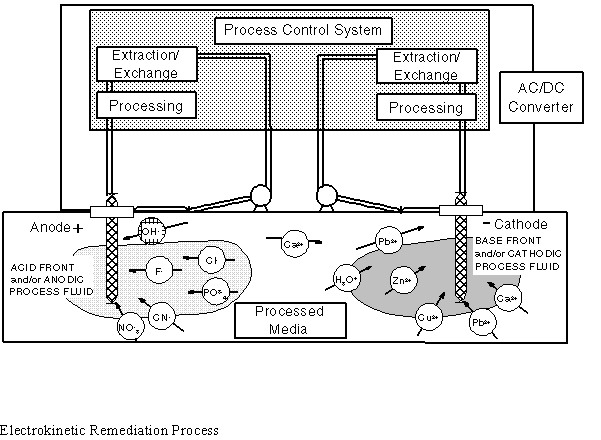
ELECTROKINETICS, INC.
(Electrokinetic Soil Processing)
Electrokinetic, Inc.'s, soil processes extract or remediate heavy metals and organic contaminants in soils. The process can be applied in situ or ex situ with suitable chemical agents to optimize the remediation. For example, conditioning fluids such as suitable acids may be used for electrode (cathode) depolarization to enhance the process.
The figure below illustrates the field-processing scheme and the flow of ions to respective boreholes (or trenches). Electrodes are placed on each side of the contaminated soil mass, and a direct current is applied. Conditioning pore fluids may be added or circulated at the electrodes to control process electrochemistry. Contaminants are electroplated on the electrodes or separated in a posttreatment unit.

An acid front migrates towards the negative electrode (cathode), and contaminants are extracted through electroosmosis (EO) and electromigration (EM). The concurrent mobility of the ions and pore fluid decontaminates the soil mass. EO and EM supplement or replace conventional pump-and-treat technologies.
Bench-scale results show that the process works in both unsaturated and saturated soils. Pore fluid flow moves from the positive electrodes (anodes) to the cathodes under the effect of the EO and EM forces. Electrode selection is important, since many metal or carbon anodes rapidly dissolve after contact with strong oxidants.
Electrokinetic soil processing extracts heavy metals, radionuclides, and other inorganic contaminants below their solubility limits. During bench-scale testing, the technology has removed arsenic, benzene, cadmium, chromium, copper, ethylbenzene, lead, nickel, phenol, trichloroethylene, toluene, xylene, and zinc from soils. Bench-scale studies under the SITE Program demonstrated the feasibility of removing uranium and thorium from kaolinite.
Limited pilot-scale field tests resulted in lead and copper removal from clays and saturated and unsaturated sandy clay deposits. Treatment efficiency depended on the specific chemicals, their concentrations, and the buffering capacity of the soil. The technique proved 85 to 95 percent efficient when removing phenol at concentrations of 500 parts per million (ppm). In addition, removal efficiencies for lead, chromium, cadmium, and uranium at levels up to 2,000 micrograms per gram ranged between 75 and 95 percent.
Based on results from the Emerging Technology Program, the electrokinetic technology was invited in 1994 to participate in the SITE Demonstration Program. For further information on the pilot-scale system, refer to the Emerging Technology Bulletin (EPA/540/F-95/504), which is available from EPA.
The SITE demonstration began in July 1995 at an inactive firing range at the Fort Polk Army Ammunition Reservation in Louisiana. The soil at the site is contaminated with lead, copper, and zinc, which have accumulated over several decades. Concentrations of lead in the sandy clay soil range from 1,000 to 5,000 ppm and are less than 100 ppm at a 3-foot depth. A 20-foot by 60-foot area will be remediated to a depth of 3 feet. Remediation of the site is expected to be completed within 9 to 12 months of processing. This demonstration represents the first comprehensive study in the United States of an in situ electrokinetic separation technology applied to heavy metals in soils.
EPA PROJECT MANAGER:
Randy Parker
U.S. EPA
National Risk Management Research
Laboratory
26 West Martin Luther King Drive
Cincinnati, OH 45268
513-569-7271
Fax: 513-569-7571
TECHNOLOGY DEVELOPER CONTACTS:
Elif Acar
Electrokinetics, Inc.
11552 Cedar Park Ave.
Baton Rouge, LA 70809
504-753-8004
Fax: 504-753-0028